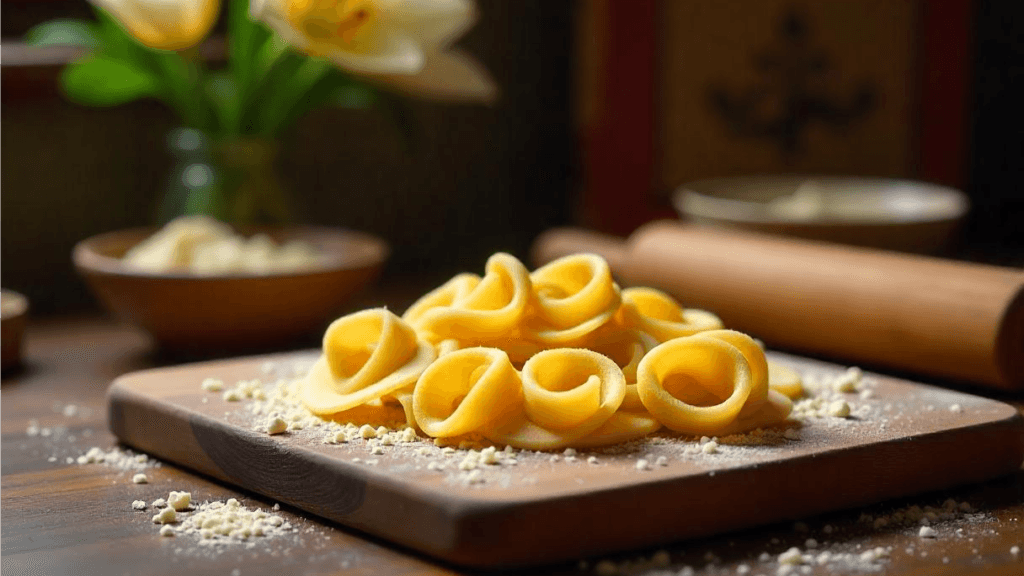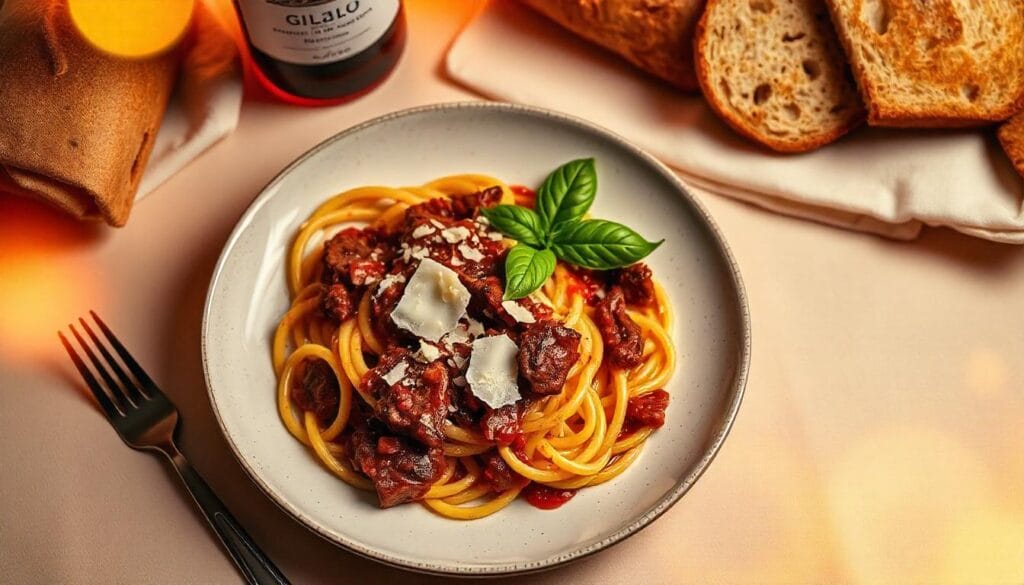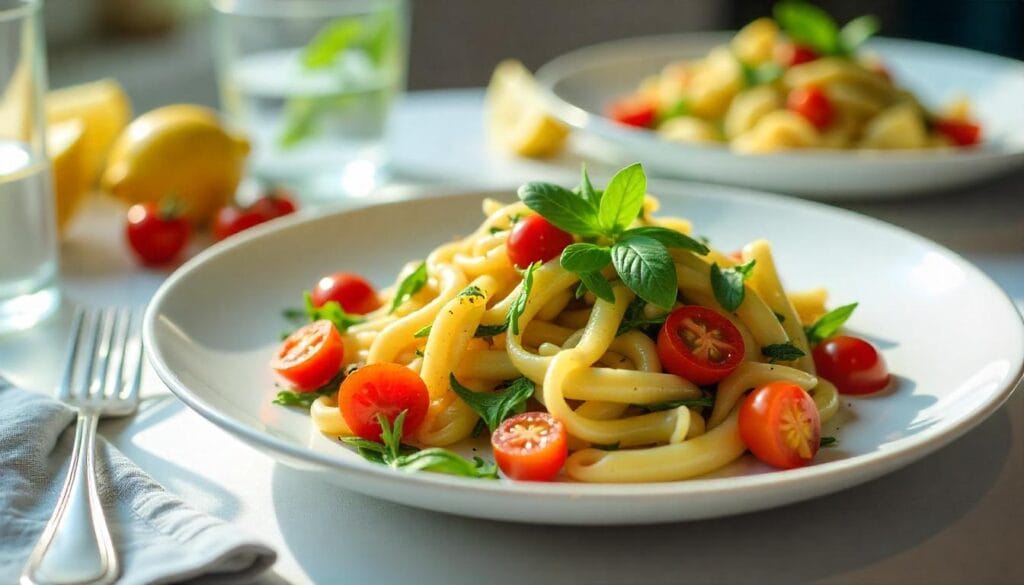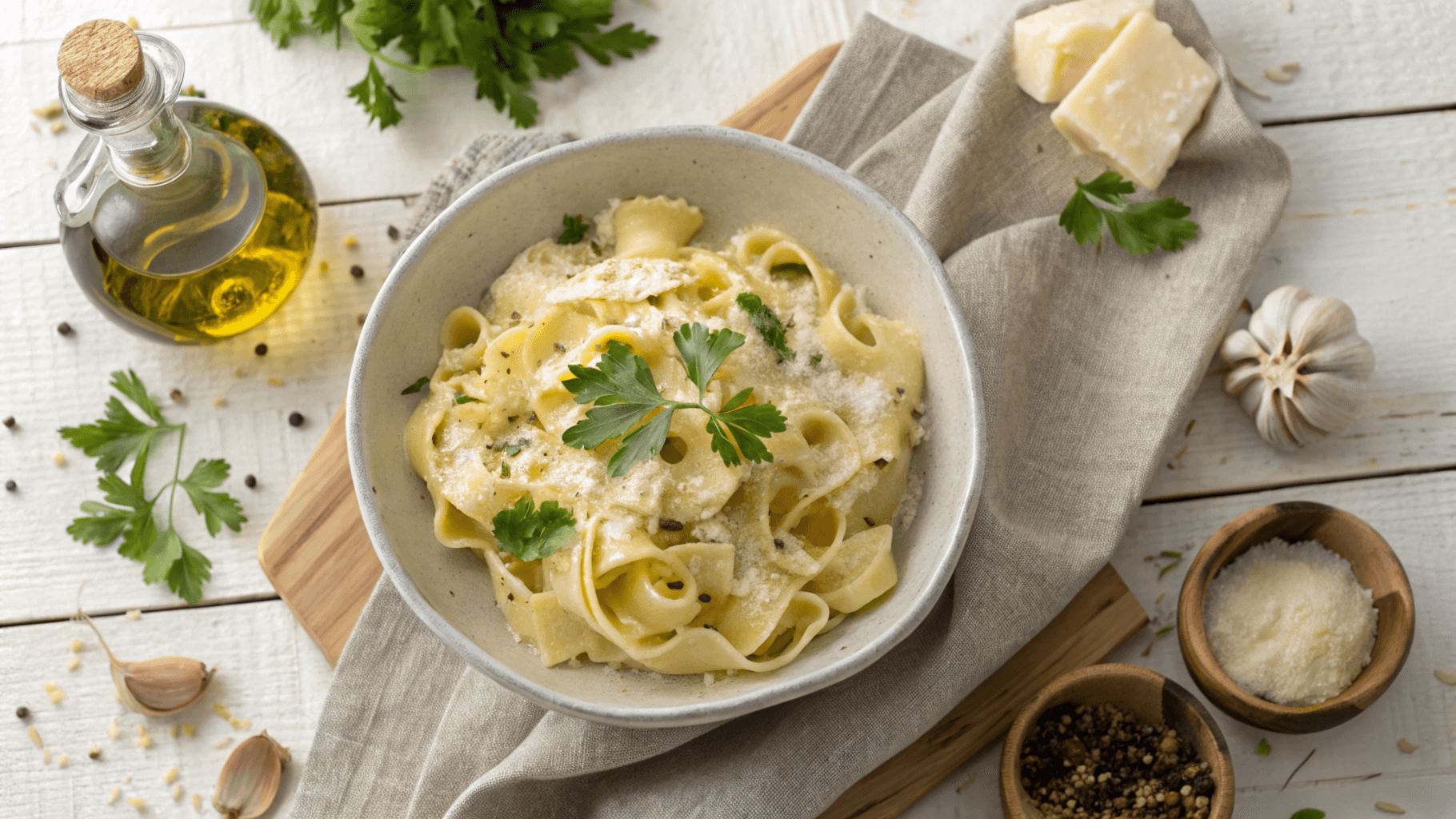When it comes to pasta, Italy has gifted the world with a vast variety of shapes, sizes, and culinary traditions. Among these treasures lies the gigli, a lesser-known yet strikingly beautiful pasta. This article dives deep into the origins, uses, and cultural significance of gigli pasta, answering questions like “What kind of pasta is a gigli?” and exploring its many facets. From its history rooted in Tuscany to the perfect sauces to pair it with, gigli pasta deserves a spot in your pantry and your heart.
Let’s embark on this flavorful journey, starting with an introduction to this elegant pasta.
Introduction to Gigli Pasta
What is Gigli Pasta?
Gigli pasta, also known as campanelle or riccioli, is a cone-shaped pasta with delicate, ruffled edges that mimic the appearance of a lily or bellflower. Its intricate design isn’t just for aesthetics—it’s a functional masterpiece, perfectly crafted to hold onto sauces and seasonings. Gigli is the Italian word for “lilies,” making it as poetic as it is practical.
This unique pasta type is a favorite among culinary enthusiasts for its versatility and ability to elevate simple dishes. Whether you’re preparing a light vegetable medley or a rich, creamy sauce, gigli pasta holds its own.
If you’re looking for an in-depth exploration of this pasta, this gigli pasta guide provides a complete overview.
Origins of the Name ‘Gigli’
The name gigli ties deeply to its Tuscan roots. Tuscany, often called the cradle of the Italian Renaissance, celebrates the lily as a symbol of purity and beauty. The pasta’s ruffled edges are reminiscent of the petals of a lily flower, further solidifying its connection to Florence, the region’s cultural and historical hub.
Interestingly, in different regions and countries, this pasta goes by other names. In the U.S., it’s more commonly referred to as campanelle (little bells), while in some Italian dialects, it’s also called riccioli, meaning “curls.”
Synonyms: Campanelle and Riccioli
If you’ve spotted pasta labeled campanelle in a store or restaurant, you’ve already encountered gigli under a different alias. The term campanelle translates to “little bells,” aptly describing its bell-shaped form. Meanwhile, riccioli, another synonym, emphasizes its curled edges, reminiscent of spirals or curls.
Despite the varying names, the essence of this pasta remains unchanged. It’s an elegant yet robust addition to any dish, combining aesthetic appeal with culinary functionality.
History and Cultural Significance of Gigli Pasta
Tuscany: The Birthplace of Gigli
Gigli pasta, as its name suggests, has strong roots in the Tuscany region of Italy. This picturesque area, known for its rolling hills and artistic heritage, is also home to some of the most iconic Italian culinary traditions. Many believe gigli originated in Tuscany, specifically inspired by Florence’s deep connection to the lily, which has been the city’s emblem for over a thousand years.
The city of Florence, called Firenze in Italian, was historically referred to as Florentia, which translates to “flowering” in Latin. This linguistic nod to flowers ties directly to the pasta’s name and its symbolic link to the lily. What kind of pasta is a gigli? It’s more than just food—it’s a piece of Tuscany’s artistic and botanical history.

Florence’s Lily Emblem and Gigli Connection
The lily flower, or giglio in Italian, is woven into Florence’s identity, adorning its coat of arms and architecture. The design of gigli pasta pays homage to this legacy, making it not just a culinary delight but also a cultural emblem.
Many Tuscan pasta makers proudly associate gigli with Florence’s heritage, branding it as gigli toscani. For centuries, this pasta has served as both a symbol of regional pride and a centerpiece in traditional recipes. It’s fascinating how something as simple as pasta can reflect the soul of an entire region.
The Role of Gigli in Tuscan Cuisine
Tuscany’s rich culinary tradition highlights gigli pasta in recipes that showcase the region’s fresh, seasonal ingredients. Locals use it in hearty ragus, creamy vegetable-based dishes, and baked casseroles. Whether paired with venison ragu or Swiss chard, gigli effortlessly bridges the gap between rustic and refined cuisine.
Its association with Florence and Tuscany has cemented its place not just in kitchens but in Italian culture. Indeed, what kind of pasta is a gigli? It’s one that tells a story of history, art, and gastronomy.
For a creative twist, consider trying it in a recipe like Beef Queso Mac and Cheese, which combines cheesy indulgence with a hearty base.
Gigli vs. Other Pasta Shapes
Unique Features of Gigli Pasta
When you think of gigli, its distinctive shape immediately sets it apart. Unlike penne or spaghetti, which are more straightforward in design, gigli’s ruffled edges and cone-like structure offer a unique visual and textural experience. These ruffles are not just decorative—they excel at trapping sauces, ensuring every bite is flavorful.
Compared to other types of pasta, gigli is a feast for the eyes and palate. Its versatility allows it to work well in both light and hearty dishes, from simple tomato sauces to decadent Alfredo recipes.
Comparing Gigli with Campanelle and Fusilli
While campanelle and gigli are often used interchangeably, the latter has a more pronounced connection to its Tuscan roots. Both share a bell-shaped form, but gigli’s heritage sets it apart. Fusilli, on the other hand, is spiral-shaped and lacks the ruffled, petal-like edges that make gigli so distinctive.
When choosing between these, the question what kind of pasta is a gigli? becomes essential. Gigli is your go-to for dishes requiring a pasta that holds onto chunky sauces, while fusilli might suit lighter, oil-based recipes.
When to Use Gigli Over Other Pasta Types
Gigli stands out in recipes where texture and sauce retention are key. Its ruffled edges hold creamy sauces beautifully, making it ideal for recipes like creamy mushroom pasta or baked casseroles. Moreover, its compact yet intricate shape makes it perfect for elevating a simple weeknight dinner to something more elegant.
So, what kind of pasta is a gigli? It’s the kind that not only adds flavor but also enhances the overall dining experience. For cooks seeking a balance between style and substance, gigli is hard to beat.
How to Cook Gigli Pasta Perfectly
Step-by-Step Cooking Instructions
Cooking this pasta is as simple as it is rewarding. To achieve that perfect al dente texture, follow these straightforward steps:
- Bring a Large Pot of Water to a Boil: Use at least 4-5 quarts of water for every pound of the pasta to prevent sticking.
- Add Salt Generously: A good rule of thumb is 1-2 tablespoons of salt per pot. This enhances the flavor of the pasta itself.
- Cook the Pasta: Add the gigli pasta to the boiling water and stir occasionally to prevent clumping. Check the package instructions for cooking time, but start testing for doneness a minute early.
- Drain and Save Some Pasta Water: Reserve a cup of the starchy cooking water—it works wonders for adjusting sauce consistency later.
What kind of pasta is a gigli? It’s a pasta that requires gentle care but rewards you with an unmatched culinary experience.
Common Mistakes to Avoid While Cooking Gigli
Even experienced cooks can sometimes make mistakes. Avoid these common pitfalls:
- Under-Salting the Water: Properly salted water is key to flavorful pasta.
- Overcooking: Gigli’s delicate ruffles can quickly become mushy if overcooked. Stick to the suggested cooking times.
- Rinsing the Pasta: Never rinse pasta after cooking—it strips away the starch that helps sauces cling.
By mastering these basics, you’ll ensure your pasta is a crowd-pleaser every time.
Tips for Achieving Perfect Al Dente Texture
To truly highlight what kind of pasta is a gigli, aim for an al dente bite. This means the pasta should be firm yet tender, offering a slight resistance when bitten. For added precision, taste-test the pasta as it nears the end of its cooking time.
Want more delicious pasta tips? Check out the article on Marry Me Chicken Pasta for another mouthwatering dish idea.
Best Sauces and Dishes for Gigli Pasta
Creamy Sauce Pairings
Gigli pasta’s ruffled edges make it the perfect candidate for creamy sauces. Rich Alfredo, garlic Parmesan, or even a tangy lemon cream sauce cling beautifully to its unique shape. The pasta’s ability to hold sauces ensures every bite is bursting with flavor.
Hearty Meat-Based Sauces Like Venison Ragu
If you’re craving something heartier, pair gigli with a robust meat sauce like venison ragu. The sauce’s chunks of meat nestle into the pasta’s folds, creating a symphony of textures and flavors. This pairing is particularly popular in Tuscany, where gigli often stars in traditional recipes.

Vegetable-Based and Baked Dishes
For a lighter option, try pairing gigli with roasted vegetables or a fresh pesto. Its sturdy shape also makes it ideal for baked pasta dishes. Layer gigli with a béchamel sauce, mozzarella, and spinach, and bake until golden brown for a comforting meal.
Not sure what to make next? Browse the Barilla Lasagna Recipe for more Italian-inspired ideas.
Where to Find and Buy Gigli Pasta
Availability in Italy vs. International Markets
If you’ve ever wondered, what kind of pasta is a gigli and where you can find it, you’re not alone. While This pasta has deep roots in Tuscany, it’s surprisingly less common in other parts of Italy. Local supermarkets in the Veneto region, for instance, rarely stock it, even though major brands like Barilla and De Cecco produce it.
For international markets, it is often sold under its alternative name, campanelle. You’re more likely to find it in specialty grocery stores or Italian markets. Additionally, many artisan pasta makers sell gigli online, making it accessible no matter where you live.
Top Artisan and Commercial Gigli Brands
When choosing gigli pasta, consider both artisan and commercial options. Artisan brands often use traditional methods, like bronze-die extrusion, to create pasta with a rough texture that clings to sauces. Commercial brands, on the other hand, offer convenience and affordability. Both have their merits, depending on your needs.
Best Online Stores for Gigli Pasta
Shopping online is one of the easiest ways to get your hands on gigli pasta. Many Italian specialty shops ship internationally, offering high-quality gigli straight to your doorstep. Websites like Amazon or niche pasta stores often stock both artisan and branded gigli, giving you plenty of choices.
For more Italian-inspired dishes, check out the Ultimate Guide to Baked Ziti.
FAQs :
What Makes Gigli Different From Campanelle?
While gigli and campanelle are often used interchangeably, the distinction lies in their origins. Gigli, deeply rooted in Tuscan culture, is the authentic name for this pasta in Italy. Campanelle, which translates to “little bells,” is more commonly used in international markets. Despite the different names, the shape and culinary uses are identical.
Can You Substitute Gigli Pasta?
Yes, gigli pasta can often be substituted with similar shapes like fusilli or cavatappi. However, its unique ruffled edges make it especially suited for creamy or chunky sauces. If you’re making a dish that relies on sauce clinging to the pasta, gigli is your best bet.
What Recipes Work Best With Gigli Pasta?
Gigli’s versatility shines in many recipes, from creamy Alfredo to hearty meat sauces. It’s also fantastic in baked dishes and lighter options like pesto. Simply put, what kind of pasta is a gigli? It’s the kind that pairs well with almost anything!
Is Gigli Pasta Gluten-Free?
Traditional gigli pasta is made from semolina flour, which contains gluten. However, some brands offer gluten-free versions made from rice or corn flour, making this delicious pasta accessible to everyone.
Health and Nutritional Aspects of Gigli Pasta
Nutritional Profile of Gigli Pasta
When it comes to understanding what kind of pasta is a gigli, knowing its nutritional value is essential. Traditional pasta, made from durum wheat semolina, is a good source of carbohydrates and provides a moderate amount of protein. It’s low in fat and cholesterol, making it a relatively healthy base for meals when paired with wholesome ingredients.
For those watching their fiber intake, whole-grain or enriched gigli options are available. These variants often pack in more nutrients, like dietary fiber and essential vitamins, offering a more balanced meal option.

Health Benefits and Considerations
This pasta, like most traditional pasta, is versatile and easy to integrate into a balanced diet. It’s a great source of energy, especially for active individuals. Pair it with lean proteins, vegetables, and healthy fats to create a well-rounded meal.
However, portion control is key. Since gigli is typically paired with rich sauces, it’s easy to overindulge. For those with dietary restrictions, such as gluten intolerance, gluten-free gigli options are a fantastic alternative that doesn’t compromise on taste or texture.
Is Gigli Pasta Suitable for Special Diets?
The adaptability of this pasta makes it a favorite for various dietary preferences. While traditional gigli is not gluten-free, there are options made from rice or corn flour that cater to gluten-free diets. For low-carb eaters, zucchini or vegetable-based gigli alternatives are also worth exploring.
Conclusion
Gigli as a Symbol of Italian Culinary Art
At its core, what kind of pasta is a gigli? It’s a celebration of Italian artistry, combining beauty with functionality. Its delicate, lily-shaped design not only connects it to Tuscany’s rich heritage but also makes it a standout addition to any dish. This pasta transforms simple recipes into culinary masterpieces.
Versatility in Recipes Across Cultures
One of gigli’s greatest strengths is its versatility. From creamy Alfredo to hearty meat sauces and even lighter pesto-based dishes, gigli excels in bringing out the best in any recipe. Its unique ruffles are designed to hold sauces, ensuring every bite is flavorful and satisfying.
How to Incorporate Gigli into Modern Cooking
Bringing gigli into your kitchen is an invitation to experiment. Use it in traditional Italian recipes or incorporate it into modern fusion dishes. Whether baked, boiled, or tossed in a fresh salad, gigli pasta is a culinary canvas waiting to be painted with your favorite flavors.


5 thoughts on “What Kind of Pasta is a Gigli? An In-Depth Exploration”